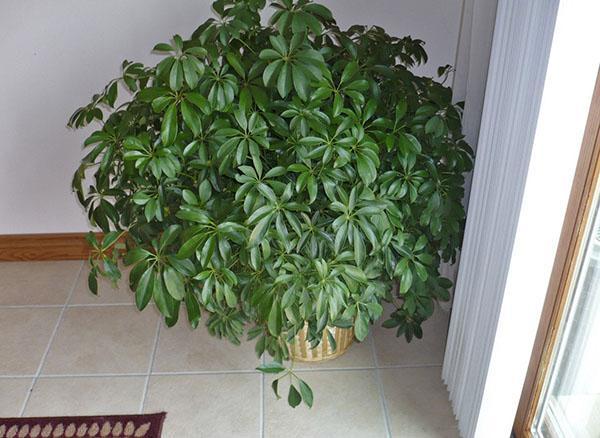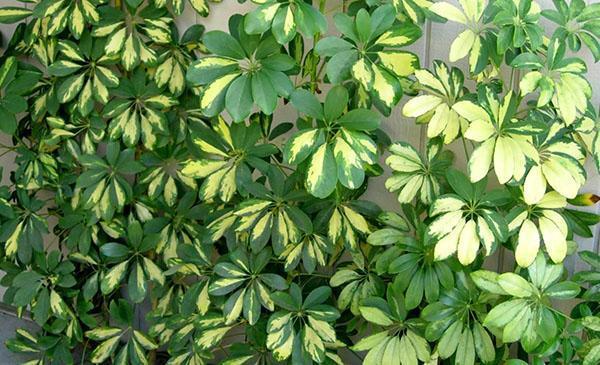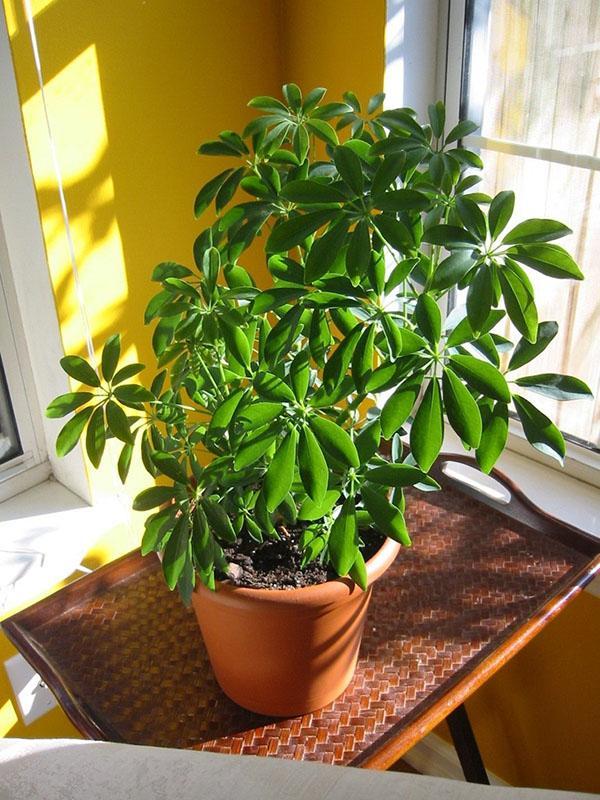Simple shefflera care at home
 Over the past few decades, this decorative deciduous flower has gained immense popularity among flower growers around the world. Caring for a shefflera at home is simple. This is one of the reasons for the popularity of the plant among amateur flower growers.
Over the past few decades, this decorative deciduous flower has gained immense popularity among flower growers around the world. Caring for a shefflera at home is simple. This is one of the reasons for the popularity of the plant among amateur flower growers.
Flower description

Shefflers are home to the rainforests of Australia, New Zealand, as well as Southeast Asia, the Malay Archipelago and Indonesia.
In its natural environment, the plant settles on the trunks of large trees to be as close to the light as possible.
Many are interested in whether a chef blooms at home? In this regard, it should be said that budding is practically not observed in the room. But in natural conditions, it releases inflorescences in the form of huge panicles or brushes, resembling tentacles. For this feature, it is often called the octopus tree.
Even without the Schefflera flowers, it is a real decoration for any private collection.
Shefflera care at home: light and temperature
 A lot of bright light is needed at any time of the year. But direct sunlight will burn the leaves. East or west facing windows are best. If you put the flowerpot on the south side, take care of the curtains from the sun. To keep the leaves decorative on cloudy autumn and winter days, highlight the plant fluorescent lamps.
A lot of bright light is needed at any time of the year. But direct sunlight will burn the leaves. East or west facing windows are best. If you put the flowerpot on the south side, take care of the curtains from the sun. To keep the leaves decorative on cloudy autumn and winter days, highlight the plant fluorescent lamps.
The variegated look requires more light, and the varieties with solid green leaves are not as sensitive to shading. Analyze this fact if the shefflera is not growing and you no longer know what to do.
As a tropical plant, this flower does not respond well to high air temperatures. She feels best when the thermometer reads + 18 - 22 in summer and + 13 - 16 in winter. If the temperature rises above + 23 °, shefflera woody slows down in growth. Hypothermia occurs at rates below + 12 °. Therefore, one should be very careful about such parameters. Drafts are also contraindicated.
When caring for a shefflera at home, you need to take care that the plant pot is away from batteries, radiators, air conditioners and fans.
Strict watering regime
 You need to closely monitor the state of the soil in the pot. Schefflera reacts sharply to the slightest waterlogging of an earthen coma. Root rot is very easy to form. However, it is also impossible to dry out the flower. We saw that the topsoil is drying up - water the plant a little.
You need to closely monitor the state of the soil in the pot. Schefflera reacts sharply to the slightest waterlogging of an earthen coma. Root rot is very easy to form. However, it is also impossible to dry out the flower. We saw that the topsoil is drying up - water the plant a little.
To care for a shefflera at home, use settled water a little warmer than room temperature.
On particularly hot days, more intense watering... The rates range from once every 5 days to once every 2 - 3 days (for hot summer). Remember that everything is purely individual, and depends on the degree of evaporation of moisture and the ambient temperature. Be sure to drain excess water from the sump after irrigation.
It is not recommended to transplant the sheffler immediately after purchase.
It is necessary for the plant to get used to new conditions. If you want to change the flower of the ground, wait at least a month.
This culture is a big fan of high air humidity. To help her survive the summer and heating season without loss, often spray the leaves with water (standing, the same temperature as for irrigation). It is also helpful to periodically wipe the plates with a damp cloth. So you not only provide the necessary moisture, but also remove excess dust, which will make it easier for the plant to breathe.
If you don't have time to sprinkle daily, replace it with a warm shower every two weeks.
Soil selection and transplant features
 It is best for shefflers to take a nutritious soil with a slightly acidic reaction. If it is possible to prepare the soil mixture yourself, use it.
It is best for shefflers to take a nutritious soil with a slightly acidic reaction. If it is possible to prepare the soil mixture yourself, use it.
The following formulations are considered the most useful:
- Add humus and sand to a mixture of leafy and soddy land.
- Mix in equal proportions leaf and sod soil, as well as peat, humus and sand.
- Also, for growing shefflers, a substrate for palms and roses is suitable.
The transplant depends on the age of your plant. A young specimen needs to change the land every spring, since the schiffler grows quickly at this age. An adult flower growing in a large tub may not be transplanted at all. It is enough to replace the top layer of the earth once a year. This must be done carefully so as not to harm the roots.
Increase the size of the pot gradually. During each transplant, take a container approximately 5 cm larger than the previous one.
An unnecessarily huge pot will require more water when watering. So you run the risk of flooding the sheffler.
Top dressing scheme
 For a flower like a sheffler, home care must necessarily include fertilizers. Most of all she needs it during active growth. Usually this period falls on the end of March and lasts all September. The frequency of dressings is 1-2 times a month. For this, mineral fertilizers, organic matter (weak solution) and humates are used. They can be added to water for irrigation or applied after irrigation to still damp soil.
For a flower like a sheffler, home care must necessarily include fertilizers. Most of all she needs it during active growth. Usually this period falls on the end of March and lasts all September. The frequency of dressings is 1-2 times a month. For this, mineral fertilizers, organic matter (weak solution) and humates are used. They can be added to water for irrigation or applied after irrigation to still damp soil.
The accumulation of fertilizers in the ground is much more dangerous than a lack of them. The soil turns sour, and the roots gradually die off.
First, the smallest roots, and then the whole root.
From organic matter, cow dung has a beneficial effect. They also use infused weeds tops. Both products are poured with water (1 part organic to 3 parts water), then left to ferment for 5 to 10 days. The finished infusion is again diluted with liquid at least 10 times. But bird droppings for fertilizers are used extremely rarely. It must be diluted even more thoroughly (at least 40 times).
Choosing your own breeding method
 The plant propagates by seeds, cuttings and rooting of air layers. How to care for the sheffler seedlings in the house can be seen in the photo.
The plant propagates by seeds, cuttings and rooting of air layers. How to care for the sheffler seedlings in the house can be seen in the photo.
Seeds
 It is rare for anyone to bring this plant to flowering and collect seeds at home. But growing it from purchased grains is not as difficult as it seems. Seeds are sown no later than January or February. They are pre-soaked in zircon solution.
It is rare for anyone to bring this plant to flowering and collect seeds at home. But growing it from purchased grains is not as difficult as it seems. Seeds are sown no later than January or February. They are pre-soaked in zircon solution.
The land is usually taken the same as for an adult specimen. When the seeds are located, moisten the substrate with a spray bottle. You can sow directly into small pots or cups, so that later you do not waste time diving. Put each container in a bag and tie it. Air out your makeshift greenhouse from time to time for a few minutes.
Cuttings
 Planting material is taken only from absolutely healthy plants. Find a fairly stiff twig and cut it off with a knife with a sharp blade (the tool must be pre-treated with an antibacterial agent). Next, place the cut shoot in a glass with a stimulant solution for about 5 to 7 hours. Then transfer to the prepared substrate. Provide greenhouse conditions and frequent ventilation.A photo of this stage of caring for a shefflera at home can be seen above.
Planting material is taken only from absolutely healthy plants. Find a fairly stiff twig and cut it off with a knife with a sharp blade (the tool must be pre-treated with an antibacterial agent). Next, place the cut shoot in a glass with a stimulant solution for about 5 to 7 hours. Then transfer to the prepared substrate. Provide greenhouse conditions and frequent ventilation.A photo of this stage of caring for a shefflera at home can be seen above.
Layers
 In the spring, a small incision is made on the stem. Moss should be soaked in a solution of universal fertilizer and carefully close the incision with it. A film is wound over the sphagnum. The moss is constantly kept moist. The first roots will appear no earlier than six months later. Then they wait about another couple of months until they get stronger. Then the top is cut off along with the roots and planted in the ground. The remaining trunk is removed almost at the root. Watering is not stopped. Over time, new shoots are formed.
In the spring, a small incision is made on the stem. Moss should be soaked in a solution of universal fertilizer and carefully close the incision with it. A film is wound over the sphagnum. The moss is constantly kept moist. The first roots will appear no earlier than six months later. Then they wait about another couple of months until they get stronger. Then the top is cut off along with the roots and planted in the ground. The remaining trunk is removed almost at the root. Watering is not stopped. Over time, new shoots are formed.
Important! The flower sap is poisonous. Avoid contact with skin and mucous membranes of the eyes. When shaping and cutting shifflers, all operations are best carried out with rubber gloves.
 Possible difficulties in growing:
Possible difficulties in growing:
- The yellow color of the leaves is a sign of a lack of nutrients in the soil. Feed the plant urgently.
- Leaves fall, the shefflera does not grow - the temperature regime is violated, the pot is in a draft, or mistakes were made when watering.
- Twisted, blackened leaves, the appearance of dropsy (the reverse side of the plate is covered with pimples) - the earth does not have time to dry out between waterings, or unsettled water was used.
If you do not monitor the humidity of the air and the cleanliness of the plant, aphids, spider mites or scale insects may appear.
Without intervention, this plant practically does not branch. It is not difficult to form a sheffler crown at home.
A photo of how to do this can be seen above.
This plant will be a real gift for any flower lover. In addition, it not only pleases the eye, but also clears the air from nicotine and poisonous tar. And her colorful umbrellas will be a reliable shelter from the blues at any time of the year.